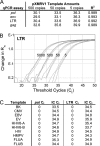Absence of XMRV retrovirus and other murine leukemia virus-related viruses in patients with chronic fatigue syndrome
- PMID: 21543496
- PMCID: PMC3126563
- DOI: 10.1128/JVI.00693-11
Absence of XMRV retrovirus and other murine leukemia virus-related viruses in patients with chronic fatigue syndrome
Abstract
Chronic fatigue syndrome (CFS) is a multisystem disorder characterized by prolonged and severe fatigue that is not relieved by rest. Attempts to treat CFS have been largely ineffective primarily because the etiology of the disorder is unknown. Recently, CFS has been associated with xenotropic murine leukemia virus-related virus (XMRV) as well as other murine leukemia virus (MLV)-related viruses, though not all studies have found these associations. We collected blood samples from 100 CFS patients and 200 self-reported healthy volunteers from the same geographical area. We analyzed these in a blind manner using molecular, serological, and viral replication assays. We also analyzed samples from patients in the original study that reported XMRV in CFS patients. We did not find XMRV or related MLVs either as viral sequences or infectious viruses, nor did we find antibodies to these viruses in any of the patient samples, including those from the original study. We show that at least some of the discrepancy with previous studies is due to the presence of trace amounts of mouse DNA in the Taq polymerase enzymes used in these previous studies. Our findings do not support an association between CFS and MLV-related viruses, including XMRV, and the off-label use of antiretrovirals for the treatment of CFS does not seem justified at present.
Figures





Similar articles
-
Contamination of human DNA samples with mouse DNA can lead to false detection of XMRV-like sequences.Retrovirology. 2010 Dec 20;7:109. doi: 10.1186/1742-4690-7-109. Retrovirology. 2010. PMID: 21171973 Free PMC article.
-
No evidence of murine-like gammaretroviruses in CFS patients previously identified as XMRV-infected.Science. 2011 Jul 1;333(6038):94-7. doi: 10.1126/science.1204963. Epub 2011 May 31. Science. 2011. PMID: 21628393
-
Xenotropic murine leukemia virus-related virus is not associated with chronic fatigue syndrome in patients from different areas of the us in the 1990s.Virol J. 2011 Sep 24;8:450. doi: 10.1186/1743-422X-8-450. Virol J. 2011. PMID: 21943244 Free PMC article.
-
Lack of evidence for a role of xenotropic murine leukemia virus-related virus in the pathogenesis of prostate cancer and/or chronic fatigue syndrome.Virus Res. 2012 Jul;167(1):1-7. doi: 10.1016/j.virusres.2012.04.004. Epub 2012 Apr 15. Virus Res. 2012. PMID: 22531412 Review.
-
XMRV, prostate cancer and chronic fatigue syndrome.Br Med Bull. 2011;98:61-74. doi: 10.1093/bmb/ldr010. Epub 2011 May 6. Br Med Bull. 2011. PMID: 21551158 Review.
Cited by
-
In vitro assembly of virus-like particles of a gammaretrovirus, the murine leukemia virus XMRV.J Virol. 2012 Feb;86(3):1297-306. doi: 10.1128/JVI.05564-11. Epub 2011 Nov 16. J Virol. 2012. PMID: 22090120 Free PMC article.
-
Emerging infectious agents and the nation's blood supply: responding to potential threats in the 21st century.Transfusion. 2013 Feb;53(2):438-54. doi: 10.1111/j.1537-2995.2012.03742.x. Epub 2012 Jun 13. Transfusion. 2013. PMID: 22690676 Free PMC article. No abstract available.
-
No association between XMRV or related gammaretroviruses in Australian prostate cancer patients.Virol J. 2013 Jan 10;10:20. doi: 10.1186/1743-422X-10-20. Virol J. 2013. PMID: 23305518 Free PMC article.
-
In-depth investigation of archival and prospectively collected samples reveals no evidence for XMRV infection in prostate cancer.PLoS One. 2012;7(9):e44954. doi: 10.1371/journal.pone.0044954. Epub 2012 Sep 18. PLoS One. 2012. PMID: 23028701 Free PMC article.
-
False negative results from using common PCR reagents.BMC Res Notes. 2011 Oct 27;4:457. doi: 10.1186/1756-0500-4-457. BMC Res Notes. 2011. PMID: 22032271 Free PMC article.
References
-
- Carruthers B. M., et al. 2003. Myalgic encephalomyelitis/chronic fatigue syndrome. J. Chronic Fatigue Syndr. 11:7–115
-
- Devanur L. D., Kerr J. R. 2006. Chronic fatigue syndrome. J. Clin. Virol. 37:139–150 - PubMed
-
- Fukuda K., et al. 1994. The chronic fatigue syndrome: a comprehensive approach to its definition and study. International Chronic Fatigue Syndrome Study Group. Ann. Intern. Med. 121:953–959 - PubMed
MeSH terms
Substances
LinkOut - more resources
Full Text Sources
Other Literature Sources
Medical
Research Materials

